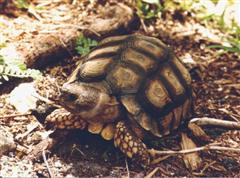Chaco Tortoise
Argentine Tortoise Scientific Name: Geochelone chilensis
Sun, 13th July, 2025 - 6:42 am GMT
Sponsor Ads:

Alternative Name
Argentine Tortoise Scientific Name: Geochelone chilensisBasic Info
The Chaco Tortoise is considered a threatened animal. They are becoming less populous primarily because of habitat destruction and the pet trade. Around 75,000 Chaco Tortoises are captured yearly to sell as pets in Argentina and Paraguay, however, Chaco Tortoises are rarely sold outside those areas. It is believed that around 32% of Chaco Tortoises die within one year of being caught. Chaco Tortoises are also threatened because of destruction of their habitats. Because Chacos are primarily grazing tortoises, when the ground vegetation is burnt off, they are forced to compete with larger, faster animals like goats for food. The destruction of the habitat makes it difficult for the tortoises to hide and they are easily collected. Chaco tortoises are members of the subgenus Chelonoidis, and some authors believe Chelonoidis should be considered its own genus, thus the Chaco Tortoise is sometimes listed as Chelonoidis chilensis. The Chaco Tortoise is moderately sized. They are closely related to the Red-Footed and Yellow-Footed Tortoises and are the smallest Geochelone tortoise known.
Health
Chaco Tortoises need a large enclosure, larger than most animals of their size. They should be kept outdoors as much as possible. Most Chaco Tortoises in captivity are fed on a variety of plant matter. The diet usually consists of 75% dark leafy greens and grasses such as clover and alfalfa, 15% vegetables, and 10% fruit.Habitat
Found primarily in moderately arid regions including sparsely vegetated land, grasslands with few trees and woodlandsBehavior
The Chaco Tortoise is a moderately sized tortoise from Argentina. Because they are considered an endangered species, they are rarely available as pets outside of South America. Chaco Tortoises are found primarily in moderately arid regions including sparsely vegetated land, grasslands with few trees and woodlands. It has been reported that the Chaco Tortoise hibernates in the winter, and this may explain why they retreat to deeper burrows in cold weather. They may also spend the winter in a semi-dormant state, emerging from the burrow to drink, go to the bathroom and move around. During warmer weather, the Chaco Tortoise spends most of the day in shallow burrows. In the wild, they feed primarily on shrubs, grasses, cactus pads and fruit. Because they will sometimes eat meat in captivity, it is believed that they may feed on carrion in the wild. While they live in moderately dry areas, they do enjoy soaking in water.Origin
South AmericaHistory
Chaco Tortoises are found between southwestern Bolivia, western Paraguay, northern Patagonia and northwestern Argentina. Primarily, they live in Argentina and Paraguay.Common Foods
Sulcatas are herbivores and, in the wild, get most of their food from dried grasses and leaves.Sponsor Ads:
Benchley's Law: Anyone can do any amount of work, provided it isn't the work he is supposed to be doing at that moment.
Chaco Tortoise
Coded by: BGID® | ALL RIGHTS RESERVED Copyright © 2000-2025
Disclaimer | Privacy | Report Errors / Contact | Credits


 Why haven't we as a collective earth met with aliens yet?
Why haven't we as a collective earth met with aliens yet?  World EcoSystem - Biodiversity Changes - Who is on board and who isn
World EcoSystem - Biodiversity Changes - Who is on board and who isn  Homosexual behavior stems from the mind or genetics?
Homosexual behavior stems from the mind or genetics?  The Best Text Adventure You Will Ever Play! The official site:
The Best Text Adventure You Will Ever Play! The official site:  Mouthwash - Mouthrinse - Mouth Sores - Healing Infections - Gingivitis
Mouthwash - Mouthrinse - Mouth Sores - Healing Infections - Gingivitis  Treatment for Depression
Treatment for Depression  Ultra radical and violent Islamist group that even rivals Al Qaeda
Ultra radical and violent Islamist group that even rivals Al Qaeda  An idea to have teachers who want to carry guns to school undergo some level of police training will be left up to local school districts and police departments.
An idea to have teachers who want to carry guns to school undergo some level of police training will be left up to local school districts and police departments.